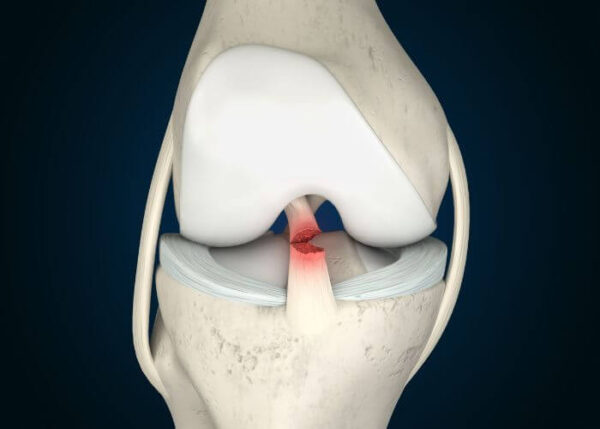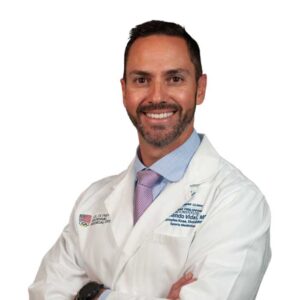What are ACL Tears in children?
The anterior cruciate ligament (ACL) is one of the four major ligaments in the knee. The ACL connects the bottom of the femur (thigh bone) to the top of the tibia (shinbone). It is responsible for helping to keep the knee stable. The ACL is also the most “talked about” ligament in the knee, because it is the most commonly injured ligament in elite and professional athletes. An ACL tear can occur if an injury stretches the ligament further than its capability. ACL tears were once an injury, exclusive to high level athletes. However, due to the increase in competitive sports in youth and adolescents, ACL tears are now one the most common knee injuries in children. Dr Armando Vidal, pediatric orthopedic knee specialist, has extensive experience in treating young patients in Vail, Aspen and the surrounding Denver, Colorado communities who have experienced an ACL tear. He has the unique experience of having treated and published extensively on these injuries in kids and at the same time has treated these injuries in collegiate, Olympic and professional athletes.

What causes an ACL tear?
The cause of an anterior cruciate ligament tear in kids is most often, sports related. The mechanism of injury can occur from jumping, running or suddenly changing direction while the foot is planted. Contact sports are also main contributors to ACL tears in pediatrics, especially football, lacrosse and soccer. Nearly half of all anterior cruciate ligament injuries in adolescents occur in combination with other knee injuries, such as meniscus tears, or other ligament tears.
What are the symptoms of a torn ACL in adolescents?
In many cases, children and adolescents experience the following symptoms:
- Feeling their knee “give way” along with an audible “pop”
- Knee swelling within the next few hours
- Inability to continue the sport they were participating in
- Pain, increasing after the injury
- Difficulty putting weight on the injured knee
- Difficulty in bending or straightening the affected leg
How are ACL tears different in children than in adults?
It is important to see an orthopedic pediatric sports medicine specialist like Dr. Armando Vidal, who has extensive experience with ACL injuries in children. He understands the primary difference between the adult knee and a child’s knee is the growth center, or physis (also called “growth plate”). These translucent, cartilaginous discs are responsible for longitudinal growth of long bones. The physes are also the weakest part of the knee. In a mature adult, the same pattern of injury would tear a ligament or cartilage in the knee. However in children, a similar injury is much more likely to fracture the bones through the growth center of the knee.
How are anterior cruciate ligament injuries diagnosed in kids?
Dr. Vidal will obtain a complete patient history as well as information on the events leading up to the injury. Diagnostic imaging, such as an MRI scan can help him see all of the structures of the knee. Since the meniscus is often torn at the same time as the ACL in children, he will assess both. The physical examination could include the Lachman test or the Pivot Shift test which are often used to determine if an ACL tear is present.
It is important to note that in pediatric ACL tears, the skeletal age of the child needs to be taken into careful consideration. Dr. Vidal will cautiously plan his surgery to take necessary care and precautions around the growth plates in the knee.
How are ACL tears in pediatric patients treated?
Dr. Vidal specializes in the treatment of ACL tears for all ages and athlete levels. The specific technique for repair or reconstruction depends on the patient’s age, health and expected outcome.
Surgical Treatment:
In adolescents who are within a year or two of skeletal maturity, Dr. Vidal may feel the risk is small and a standard ACL reconstruction can be performed. However, for younger patients, who still have open growth plates ACL reconstruction techniques require modifications that avoid injury to the growth plate. Dr. Vidal uses physis sparing surgical techniques to avoid growth disturbances in the bones. This requires specialized techniques, grafts and rehabilitation.
How long is the recovery after a Pediatric ACL tear?
Parents and young patients should understand that rehabilitation is essential for a successful recovery. A physical therapy program will begin with range-of-motion exercises and will slowly advance to resistive exercises. Eventually, power and flexibility with coordination and endurance exercises are added. Dr. Vidal’s team then helps the patient develop speed and agility. Most patients can begin light activity following surgery around 4-6 weeks. Running may begin around 3 months with a complete return to sports and competitive activity around 6 to 9 months post-surgery.
Pediatric ACL Specialist
ACL tears are most common in adult athletes, however, children can still experience a partial or complete ACL tear. These injuries most commonly occur due to running or quickly turning during sports. Pediatric ACL specialist, Doctor Armando Vidal has years of experience treating children in Vail, Aspen, and the surrounding Denver, Colorado communities who have experienced an injury to their ACL. Contact Dr. Vidal’s team today!

Locations
180 S Frontage Rd W
Vail, CO 81657
226 Lusher Court
Ste 101
Frisco, CO 80443
322 Beard Creek Road
Edwards, CO 81632


